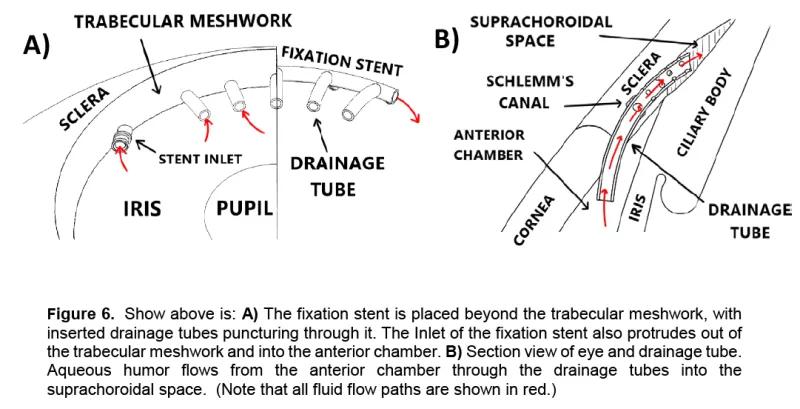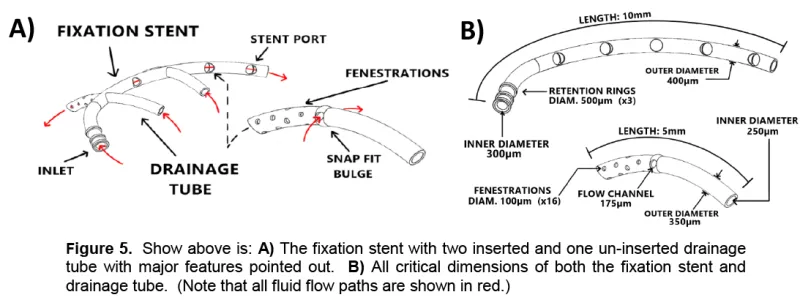Modular Glaucoma Implant with Variable Flow
This minimally invasive implantable device provides a more effective option for glaucoma treatment for patients with open angle glaucoma, angle closure glaucoma, and other forms of glaucoma.
Researchers
-
modular glaucoma implant
United States of America | Granted | 11,833,077
Figures
Technology
This device is designed to treat Glaucoma by emptying aqueous humor from the anterior chamber to the suprachoridal space. It is composed of two main components: a fixation stent designed to be inserted into the Schlemm’s canal and drainage tubes that interface with the fixation stent via snap fits. Both components are made of biocompatible and hydrophobic polyimide. They are also non-porous, encouraging biological fixation. The fixation stent is designed to match the curvature of the Schlemm’s Canal, and to protrude into the anterior chamber. This provides stability without sutures and visual confirmation of proper surgical insertion. The fixation stent enables the surgeon to adjust the flow rate of aqueous humor because it allows for up to five drainage tubes to be inserted into it. Additionally, surgeons can utilize the drainage tubes to redirect flow in the case of clogging.
Problem Addressed
Glaucoma is a disease caused by high intraocular pressure (IOP) due to poor drainage of the aqueous humor from the anterior chamber. This can damage the optic nerve, leading to blindness if left untreated. Trabeculectomy, the removal of trabecula meshwork and adjacent structures to relieve IOP, is currently the most common method for treating Glaucoma due to its long-term success rate. However, it is an invasive procedure that requires a skilled surgeon and often results in scarring. Other treatments include minimally invasive glaucoma surgery (MIGS) devices, daily medication, laser surgery, and glaucoma drainage devices. These devices are limited in efficacy due to problems with adherence, flow control, clogging, or stability in fixation within the eye. These challenges can be solved by using this easily inserted glaucoma drainage device that features flow rate adjustability, flow redirection in the case of clogging, and improved mechanical fixation with minimal scarring.
Advantages
- Improved mechanical fixation
- Minimally invasive only requiring two corneal incisions without sutures for fixation
- Ease of insertion with visual confirmation
- Surgeons with varied skill levels can easily use the device
- Flow rate adjustability
- Capable of redirecting flow in the case of clogging
- Fewer subsequent procedures
- Minimal scarring
License this technology
Interested in this technology? Connect with our experienced licensing team to initiate the process.
Sign up for technology updates
Sign up now to receive the latest updates on cutting-edge technologies and innovations.

